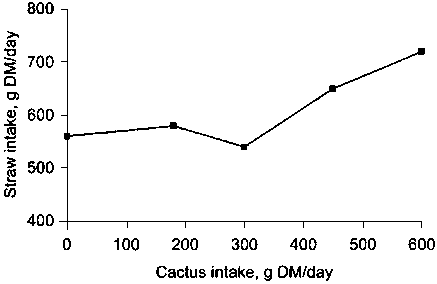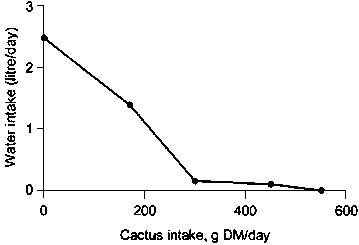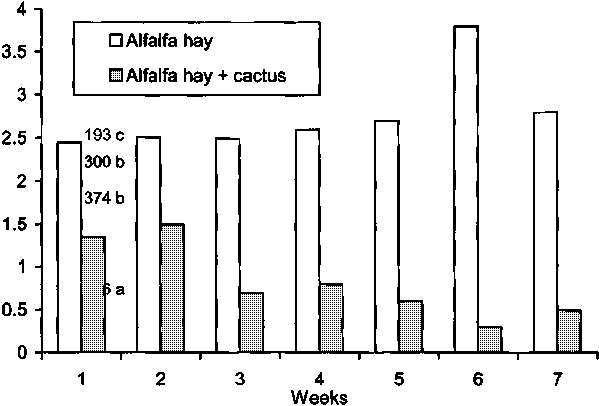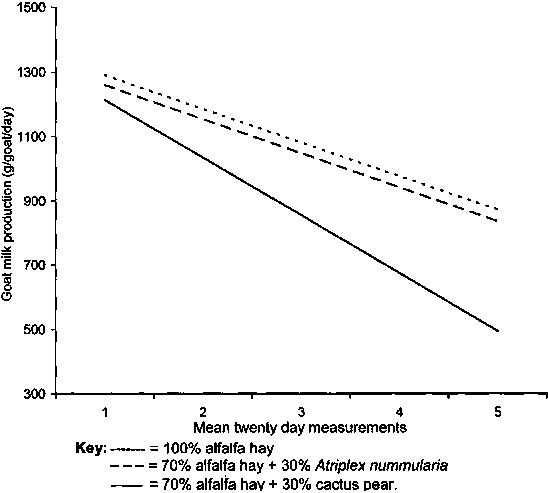Patricio AZÓCAR
|
Patricio AZóCAR Universidad de Chile |
In arid and semi-arid zones, rangelands utilized by sheep and goats are characterized by large seasonal changes in forage production, and marked seasonal and annual fluctuations in forage quality. In Coquimbo, northeast Chile, annual records show dry matter yields of 3 t/ha in a rainy year and less than 0.2 t/ha in a dry year. Shrub species ranged from 36% to 95% of the total dry matter for a dry and wet year respectively (Azócar and Lailhacar, 1990).
In Chile, goat raising is based exclusively on rangeland, allowing only their maintenance or survival. Consequently, to reach income levels of production it is necessary to supplement animal feeding with low-cost feedstuffs that supply energy and protein in the critical periods, to extend the suckling period and maintain milk and meat production (Azócar and Rojo, 1991; Azócar et al. 1996). In regard to the management of stock feeding, it was found that the use of opuntia cladodes to feed growing sheep increased by 30% the efficiency of utilization of drinking water. It is therefore proposed that supplementing sheep, goats and cattle feed in dry periods could be done using low-cost supplements.
Productivity varies considerably among species according to environmental conditions (García de Cortázar and Nobel, 1991). Crassulacean Acid Metabolism (CAM) plants, such as opuntia (Opuntia ficus-indica (L.) Miller), are often considered to have lower productivity than C3 or C4 plants. However, opuntias are highly efficient in the use of water and withstand dry periods and high temperatures. These traits make them highly promising for poor soils with limited water supply (Silva and Acevedo, 1985). The productivity of cultivated opuntia is generally below 10 t/ha/year worldwide, although it can reach 20 t/ha/year. It is an important feeding resource in rangelands of zones with Mediterranean arid climate, and is used in dairy and meat production (Azócar and Rojo, 1991; Azócar, 1992; Azócar et al., 1996; Ben Salem et al., 1996; Santana, 1992).
Utilization of opuntia for livestock feeding is an old practice in Brazil, Chile, Mexico, Sicily (Italy); South Africa, Tunisia, the southern USA, and other countries (Santana, 1992). Most Mexican forage species are thorny, which is the main constraint to their use in livestock feeding. The problem is overcome by means of simple techniques, such as propane burners (Felker, 1995). Some O. ficus-indica varieties do not have thorns, and cladode pieces are easily consumed by livestock. Another limitation of the Mexican species is their low digestibility, which could be overcome by cutting the material into small portions to facilitate its ingestion, by including other ingredients in the ration (like straw), and by utilizing two- to three-year-old plants, since younger plants are more laxative, as are older (>4 year) plants (INIF, 1983).
Advantages of opuntia include high biomass yield, high palatability and good nutritive value, evergreen habit, drought resistance and soil adaptability (Monjauze and Le Houérou, 1965; Le Houérou, 1992; Nefzaoui et al., 1993; Ben Salem et al., 1996). Opuntia has high contents of ash (260 g/kg DM) and water (926 g/kg fresh weight), and low contents of crude protein (58 g/kg DM) and neutral detergent fibre (185 g NDF per kg DM) (Ben Salem et al., 1996). The same authors reported that drinking water consumption by sheep is substantially reduced as the level of opuntia consumption increases.
Opuntia does not adapt to zones with extreme temperatures. In their place of origin - the highlands of Mexico - temperatures seldom reach +40°C or -10°C (Felker, 1995). The best temperatures for opuntia production range between 18 and 26°C, although some species can tolerate temperatures as high as 40°C and as low as -8°C. It grows in zones with annual precipitation of 200 to 250 mm, but the limits to commercial production are around 450 mm/yr (Pimienta, 1995).
Opuntia uses water more efficiently than conventional fodder crops, as illustrated in Table 25 (Le Houérou, 1994, cited by De Koch, 1998; Silva and Acevedo, 1985).
Table 25. Opuntia water use efficiency (WUE) under rainfed and irrigated conditions
|
Crop |
Water use efficiency (WUE) |
|
|
kg H2O/kg DM |
mg DM/g H2O |
|
|
Opuntia(1) |
15-43 |
23-65 |
|
Agave |
93 |
10.7 |
|
Opuntia |
267 |
3.7 |
|
Atriplex nummularia |
304 |
3.3 |
|
Pear millet |
400 |
2.5 |
|
Barley |
500 |
2.0 |
|
Sorghum |
666 |
1.6 |
|
Wheat |
750 |
1.3 |
|
Alfalfa |
1000 |
1.0 |
|
Rangeland |
2000 |
0.5 |
Sources: (1) De Koch, 1998. Other data Le Houérou, 1994.
Opuntia cultivation relies mainly on vegetative propagation, which is preferred by growers for its simplicity (Mondragón and Pimienta, 1995). Planting is done in furrows (De Koch, 1998). Rows are usually laid out 2 to 6 m apart and cladodes are planted 1 to 2 m apart. Depending on the purpose, planting density may vary from 850 to 5 000 plants/ha. Results of modelling research predict that opuntia could achieve higher biomass productivity at closer plant spacings (García de Cortázar and Nobel, 1990).
In Brazil, Santana (1992) reported a range of fresh weight yields from 106.9 to 205.0 t/ha/yr (approximately 16 to 31 t DM/ha/yr), with yield varying according to geographical zone, type of soil, fertilizer rate used, planting density and association with other crops.
In Chile, yields of cladodes have ranged from 13 t DM/ha/year in crops that only covered 30% of the land, to 40 t DM/ha/year in simulated conditions of high planting density, optimum watering and good fertilization. Average yields of 8 t/ha in non-irrigated lands of the central zone of Chile have been reported by García de Cortázar and Nobel (1990) and Riveros et al. (1990).
García de Cortázar and Nobel (1991) studied biomass productivity of opuntia at La Rinconada Agricultural Experiment Station of the University of Chile (about 20 km southwest of Santiago, Chile, [33°19’ S, 70°55’ W] 500 m elevation). Mature cladodes were planted in January 1988 (summer) at 24 plants/m2 (0.25 m × 0.17 m) facing east-west. Productivity per unit row length of the inner five rows was assumed to resemble the productivity of a uniform field. Annual predicted dry matter productivity was 40 t/ha. Further analysis indicated that dry matter productivity of opuntia could reach 50 t/ha/year.
Nutritional quality of forage opuntia depends on plant species, variety, cladode age, growing season and crop management. In general, opuntia is high in moisture content (about 85 to 90% water), it has high in vitro digestibility (about 75%), high content of soluble carbohydrates, vitamin A and ash (20% of dry matter), and low content of crude protein, crude fibre and phosphorus (Tables 26 and 27).
Table 26. Chemical composition of opuntia cladodes and alfalfa hay used to supplement goats in the suckling period (Las Cardas Experimental Station, University of Chile)
| |
Alfalfa hay |
Cactus pear cladodes |
|
Dry matter (%) |
93.06 |
15.04 |
|
Organic matter (%) |
88.75 |
90.00 |
|
Crude protein (%) |
18.86 |
3.51 |
|
Metabolizable energy (Mcal/kg) |
2.52 |
2.25 |
|
Ca (%) |
1.68 |
2.01 |
|
P (%) |
0.29 |
0.11 |
Source: Azócar and Rojo, 1991
Table 27. Chemical composition and organic matter digestibility of Acacia cyanophylla, Atriplex halimus, O. ficus-indica and barley hay (Ousseltia Central Experimental Station, INRAT, Tunisia.)
|
Composition |
Acacia cyanophylla |
Atriplex halimus |
Opuntia ficus-indica |
Barley hay |
|
Dry matter (DM) (g/kg) |
555 |
464 |
100 |
808 |
|
Organic matter (OM) (g/kg DM) |
900 |
799 |
779 |
916 |
|
Crude protein (CP) (g/kg DM) |
129 |
161 |
38 |
64 |
|
Crude fibre (CF) (g/kg DM) |
254 |
164 |
154 |
350 |
|
Neutral detergent fibre (NDF) (g/kg DM) |
469 |
328 |
197 |
605 |
|
Organic matter digestibility (%) |
51.2 |
79.3 |
82.3 |
- |
Source: Ben Salem, Nefzaoui and Abdouli (1994)
Figure 4. Cactus versus straw intake

(Source: Ben Salem et al., 1996, cited by Nefzaoui and Ben Salem, 1998).
Crude protein content decreases (5 to 3% dry matter) and crude fibre increases (9 to 20% dry matter) with cladode age (1 to 5 years). Crude protein content decreases significantly (R2 = 0.6) when cladode dry matter increases with age. This trend is similar to other fodder sources, where valuable nutrients decrease with plant age because of the relative increase in fibre content (Nefzaoui and Ben Salem, 1998).
Opuntia cladodes are highly digestible. Average values of in vivo digestibility coefficients obtained with sheep varied from 60 to 65 %, 60 to 70 %, 35 to 70% and 40 to 50 for DM, OM, CP and CF, respectively. These coefficients are quite similar to those observed with common forage crops (Nefzaoui and Ben Salem, 1996, cited by Nefzaoui and Ben Salem, 1998). Nefzaoui and Ben Salem, (1998) showed in Tunisia that combining straw with opuntia led to increased straw intake and consequently better animal performance (Figure 4).
Watering animals during summer and drought periods is a serious problem in arid zones. Animals use a lot of energy to reach water holes, and rangeland degradation in the area surrounding watering points is common. Feeding with cactus cladodes reduce watering needs in dry areas.
In Tunisia, Nefzaoui and Ben Salem (1998) showed that water intake is nil when daily cactus consumption by sheep is about 300 g of dry matter. The volume of water consumed by animals decreased from 2.4 litre for the control diet, to 0.1 litre when the level of spineless cactus was above 300
Figure 5. Opuntia intake (g DM/day) versus water intake (litre/day)

(Source: Ben Salem et al., 1996, cited by Nefzaoui and Ben Salem, 1998)
Riveros et al. (1990), in the semi-arid zone of Santiago (Chile), studied the effect of replacing alfalfa hay by opuntia cladodes on the liveweight and water intake of sheep. During two summer months, 20 lambs, 6 to 7 month old, were randomly allotted to two treatments. One group was fed on alfalfa hay at a maintenance level. The other group was fed on alfalfa hay plus opuntia cladodes that replaced about 25% of the dry matter maintenance requirements. The groups were penned, collective feed and water intake was recorded daily. A third drinking dish was located outside the dry lots to record daily evaporation. Results showed that liveweight showed only slight variation among weeks (P < 0.05). Dry matter intake was very similar between treatments (P < 0.05), the group fed on alfalfa hay fluctuated from 0.87 to 1.35 kg/animal/day, and the one fed on alfalfa plus opuntia from 0.65 to 1.32 kg/animal/day. The latter consumed between 28.1 and 31.8% of the dry matter as opuntia, starting from the second week.
Water intake differed significantly between treatments (P < 0.01): the group fed on alfalfa hay fluctuated from 2.48 to 3.26 litre/animal/day, and between 0.71 and 1.51 litre/animal/day for the animals fed on alfalfa plus opuntia. Considering both direct and indirect water intake, derived from the alfalfa and opuntia requirements to produce 1 kg dry matter, the animals that consumed alfalfa hay plus opuntia cladodes were about 30% more efficient with respect to water utilization than the group that consumed only alfalfa hay. The authors concluded that utilization of a crop like opuntia could be an interesting possibility to increase forage and animal productivity and particularly as an alternative to improve the efficiency of water utilization in dryland zones (Figure 6).
Figure 6. Weekly water intake of Suffolk ewes at La Rinconada de Maipú Experimental Station, University of Chile, Santiago

(Source: Riveros et al., 1990)
Table 28. Goat milk production at Las Cardas Agricultural Experiment Station, Coquimbo, Chile. Means of the last two months of goat’s lactation
|
Treatment |
Milk yield (g/goat/day)* |
|
Control on rangeland without supplementation |
193 c |
|
Rangeland + alfalfa hay ad libitum |
300 b |
|
Rangeland + 84% alfalfa hay + 16% cactus pear |
374 b |
|
Rangeland + 79% alfalfa hay + 21% cactus pear |
393 ab |
|
Rangeland + 66% alfalfa hay + 34% cactus pear |
436 a |
Note: * Means followed by same letter are not significantly different (Duncan’s multiple range test)
Source: Azócar and Rojo, 1991
In the arid zone of Coquimbo, Azócar and Rojo (1991) demonstrated that supplementing goats with alfalfa hay and opuntia cladodes in the suckling period significantly increased (55.4%) milk production. When only hay was provided, hay replacement with 16, 21 and 34% cladodes favoured even larger yields: 93.8, 103.6 and 125% respectively. Under local conditions, up to 34% hay could be replaced by opuntia cladodes to supplement goats fed on rangeland and stimulate milk production. This effect can be attributed to the high water content of cactus tissues. Utilization of opuntia cladodes as a summer supplement is relevant to increase milk production of local herds in zones with a Mediterranean arid climate (Table 28 and Figure 7).
Opuntia cannot be fed alone due to its poor nitrogen content, which needs to be supplemented with an appropriate and cheap source of nitrogen, such as saltbush (Atriplex sp.) or non-protein nitrogen from treated straw. Nefzaoui et al. (1995, cited by Nefzaoui and Ben Salem, 1998) showed that opuntia diets could be supplemented efficiently with Atriplex nummularia. Intake of Acacia cyanophylla was low because of its high content of condensed tannins (7% of dry matter). Tannins are also responsible for the low digestibility of acacia crude proteins (Nefzaoui and Ben Salem, 1998).
Azócar et al. (1996) evaluated the consumption, liveweight and milk production of goats feeding on green forage of either Atriplex nummularia or O. ficus-indica, as a 30% inclusion in an alfalfa-based diet. Treatments were: (1) 100% alfalfa hay; (2) 70% alfalfa hay and 30% of A. nummularia; and (3) 70% alfalfa hay and 30% opuntia. Goats were permanently confined. Replacement of alfalfa hay by the experimental forage was dry-matter based. Hay was fed unchopped, opuntia cladodes chopped, and A. nummularia as twigs. Intake was measured daily, and the amount offered was adjusted weekly. Liveweight and milk production were measured at the start of the pre-experimental and the experimental periods and from then on every twenty days.
Results showed no significant differences for dry matter intake between treatments 1 and 2 (P < 0.05), and significantly higher mean intakes for treatment 3 (Figure 7). Total liveweight gains and daily gains were significantly higher in treatment 3 compared to the others (P < 0.05). Daily and total milk production were significantly reduced by the inclusion of A. nummularia. Opuntia produced a positive effect on milk production. According to the results (Azócar et al., 1996):
(i) it is feasible to replace up to 30% of the alfalfa hay ration by opuntia without significantly affecting consumption, liveweight and milk production;
(ii) the presence of opuntia cladodes in the ration of goats in the suckling period induces a higher intake and an increase in milk production, which is probably due to the “lactose effect,” as yet not explained; and
(iii) replacement of alfalfa hay by A nummularia at a level of 30% did not significantly affect the dry matter intake, but had a negative effect on liveweight and significantly reduced milk production.
Figure 7. Goat milk production at the start of the experiment and at 20-day intervals thereafter

(Source: Azócar et al., 1996)